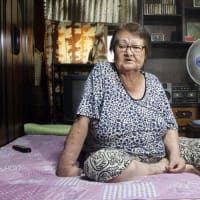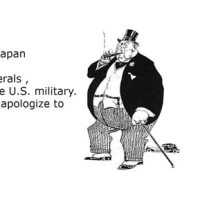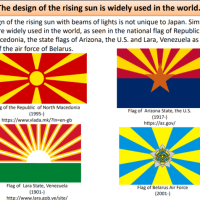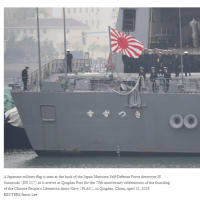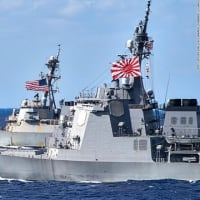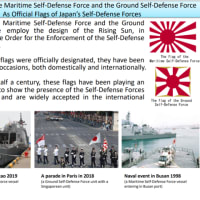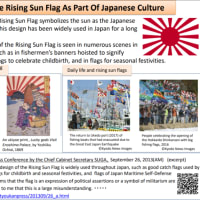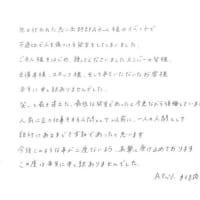いやはや、目を通すべき情報が多すぎて
レベル7について
BBC
12 April 2011 Last updated at 08:15 GMT Share this pageEmailPrint
Japan: Nuclear crisis raised to Chernobyl level
BBCが端的冷静な分析
事態が悪化したのではなく、利用できるデータの評価の現状の結論である、と。
もっとも、チェルノブイリとの違いも指摘
炉心が爆破したわけではない、放射性物質の拡散量もチェルノブイリの10分の1
対照となる世界の原発事故をあげている。
guardian
Japan upgrades nuclear crisis to same level as Chernobyl
By PHRED DVORAK, JURO OSAWA and YUKA HAYASHI
チェルノブイリは格納容器もなかった、これを比較するのは極端だ、という専門家の意見を紹介している。
reuters.
Japan raises nuclear crisis to same level as Chernoby
By Shinichi Saoshiro and Yoko Nishikawa
TOKYO | Tue Apr 12,
なぜか同じ専門家の同じ文言を引用している。
WSJ
PRIL 12, 2011
Japanese Declare Crisis at Level of Chernobyl
By PHRED DVORAK, JURO OSAWA and YUKA HAYASHI
こちらも、事故の経緯、原発の構造、放射性物質の拡散量、死傷者などを比較してチェルノブイリとの違いを指摘
LAtimes
LATimes
Japan raises nuclear crisis rating to highest level
AP・CBS
April 11, 2011 8:39 PM
PRINT TEXT
Japan raises nuclear alert to Chernobyl level
Read more: http://www.cbsnews.com/stories/2011/04/11/501364/main20052943.shtml#ixzz1JJtDIvGt
ごく普通の記事
NYT
Japan Nuclear Disaster Put on Par With Chernobyl
By HIROKO TABUCHI and KEITH BRADSHER
Published: April 11,
????サラッと読んだが該当する内容は見あたらない。(どなたかみつけたら教えて欲しい→更新参考)
それよりも、
???この記述はどうかなあ?
たしかに、例えば、飯舘村について、
飯舘村でIAEA基準超える放射性物質、避難区域の拡大圧力も
2011年 03月 31日
IAEA worried about radiation in Japan village
(AFP) – Mar 30, 2011
しかし、これをもって、urge というのか、
しかも、
Saturday, April 2, 2011
Iodine-131 level falls in Iitate, IAEA says
後日レベルは下がった、ともいわれている。
避難区域について、豪州政府については知らないが米国政府については、
「80キロ圏は避難を」米の勧告、実測データに基づかず
United States Government May Revise Its Fukushima Evacuation Advice
Japan Probe
ともいわれている。
かなりミスリーディングではなかろうか?
IAEAのサイトでは、
IAEAの推奨と合致している、といっているが・・・・・サイトが更新されていないのか?
ところで、
2011-04-11〔★★★★★原発NEWS〕 日本政府設定の要避難基準、「チェルノブイリ」移住基準のなんと4倍 ニューヨーク・タイムズが報道
と指摘するブログがある。このNYTの文章を引用しているサイトは多いのだが、この文章が元記事には、見あたらない。誰かが捏造したか、あるいは、NTTが更新でこっそり削除したのかもしれない。(→更新参考)
なお、年間積算20ミリシーベルトの基準については、以前取り上げたが、
被曝限度量の緩和提案 国際放射線防護委、移住回避促す
2011年3月26日19時41分
INTERNATIONAL COMMISSION ON RADIOLOGICAL PROTECTIO
今日付でも、
避難区域拡大「現実的」の見方 被曝積算量の試算が根拠(1/2ページ)
2011年4月12日
こうみてみると、NTTの記事はやはりミスリーディングといわざるえない。
NYTのミスリーディングな記事といえば、
Japan Probeは他のNYTのミスリーディングな記事について投稿している。
Perspectives on TEPCO’s Use of Contract Workers
Japan Probe
それはそうとして、
なぜ、保安院が今日になって評価を変えたのかか?
日経はやはくから変更を求めていた。
【社説】福島第1原発事故、「レベル6」
Fukushima Nuclear Accident Update (12 April 2011, 04:45 UTC)
福島原発事故、最悪「レベル7」と発表 チェルノブイリ並み
2011.4.12 産経
安全委がレベル7の可能性認識 危険性認識も見直し求めず
IAEA加盟国 冷静受け止め
4月12日 20時15分
ということであるが、
最初にドカッときけーーーん!といっておけばよかったとは思うが、チョロだし後出しで、非難の声は上がろう。
・・・・まあ、とりあえず。
更新
・・・・・・・・・・・・・・・・・・・・・・・・・・・・・・・・・・・・・・・・・・・・・・・・・・・
どうも同じ題名で二つ記事があげられているようだ。
Japan Nuclear Disaster Put on Par With Chernobyl
By HIROKO TABUCHI, KEITH BRADSHER and ANDREW POLLACK
Published: April 12, 2011
レベル7引き上げは当然…海外の専門家
・・・・・・・・・・・・・・・・・・・・・・・・・・・・・・・・・・・・・・・・・・・・・・・・・・
更新
この記述も削除したようだが、ネットに残っている。
Japan Nuclear Disaster Put on Par With Chernobyl
Tuesday 12 April 2011
by: Hiroko Tabuchi, Keith Bradsher and Andrew Pollack, The New York Times News Service
・・・・・・・・・・・・・・・・・・・・・・・・・・・・・・・・・・・・・・・・・・・・・・・・・・・・
なお、ソ連については削除したのだろう。
Strong aftershock as Japan urges more evacuations
Hiroko Tabuchi and Keith Bradsher, The New York Times, Updated: April 12, 2011
仮にこの数字が正しいとして、原発事故の局面を誤解しているのではないだろうか?
レベル7について
BBC
12 April 2011 Last updated at 08:15 GMT Share this pageEmailPrint
Japan: Nuclear crisis raised to Chernobyl level
Analysis
Rachel Harvey
BBC News, Tokyo
On the face of it this reclassification from a level five incident to a level seven is an alarming jump.
But the change has not been made because things have suddenly got worse at the Fukushima plant. Rather, a full assessment of the available data now suggests that a higher rating is justified.
Although the Japanese incident now equates to Chernobyl on the international scale, the two accidents are different in a number of important ways. In Chernobyl it was the reactor core itself that exploded, releasing a huge amount of radioactive material in a very short space of time. Fukushima experienced a less critical hydrogen explosion.
The initial radiation leak amounted to about a 10th of that which escaped from Chernobyl. The major concern in Japan is that the nuclear plant has not yet been brought under control, and some radioactive material is still seeping out.
BBCが端的冷静な分析
事態が悪化したのではなく、利用できるデータの評価の現状の結論である、と。
もっとも、チェルノブイリとの違いも指摘
炉心が爆破したわけではない、放射性物質の拡散量もチェルノブイリの10分の1
対照となる世界の原発事故をあげている。
World's worst nuclear incidents
Level 7: Chernobyl, Ukraine, 1986 - explosion and fire in operational reactor, fallout over thousands of square kilometres, possible 4,000 cancer cases
Level 7: Fukushima, 2011 - tsunami and possibly earthquake damage from seismic activity beyond plant design. Long-term effects unknown
Level 6: Kyshtym, Russia, 1957 - explosion in waste tank leading to hundreds of cancer cases, contamination over hundreds of square kilometres
Level 5: Windscale, UK, 1957 - fire in operating reactor, release of contamination in local area, possible 240 cancer cases
Level 5: Three Mile Island, US, 1979 - instrument fault leading to large-scale meltdown, severe damage to reactor core
guardian
Japan upgrades nuclear crisis to same level as Chernobyl
By PHRED DVORAK, JURO OSAWA and YUKA HAYASHI
Some experts criticised the move as excessive. "I think raising it to the level of Chernobyl is excessive," said Murray Jennex, associate professor at San Diego State University. "It's nowhere near that level. Chernobyl was terrible – it blew and they had no containment, and they were stuck.
"The [Japanese] containment has been holding, the only thing that hasn't is the fuel pool that caught fire. I don't see those as the same event. If they want to do that, that's fine. I think they're being overly pessimistic."
チェルノブイリは格納容器もなかった、これを比較するのは極端だ、という専門家の意見を紹介している。
reuters.
Japan raises nuclear crisis to same level as Chernoby
By Shinichi Saoshiro and Yoko Nishikawa
TOKYO | Tue Apr 12,
Several experts said the new rating exaggerated the severity of the crisis.
"It's nowhere near that level. Chernobyl was terrible -- it blew and they had no containment, and they were stuck," said nuclear industry specialist Murray Jennex, an associate professor at San Diego State University in California.
"Their containment has been holding, the only thing that hasn't is the fuel pool that caught fire.
なぜか同じ専門家の同じ文言を引用している。
WSJ
PRIL 12, 2011
Japanese Declare Crisis at Level of Chernobyl
By PHRED DVORAK, JURO OSAWA and YUKA HAYASHI
While the new assessment puts Fukushima on a par with Chernobyl, there are key differences between the two, suggesting the Ukraine disaster was still far more serious.
In the case of Chernobyl, a graphite fire burned uncontrolled for days, spewing out radioactive smoke that spread around the world. Fukushima, unlike Chernobyl, has a containment structure, which, even if damaged, has meant that the Japanese accident has shown "much, much, much lower'' traces of far-flung radiation, Wolfgang Weiss, chair of the United Nations Scientific Committee on the Effects of Atomic Radiation, said in Vienna last week.
The release from Fukushima of tens of thousands of terabecquerels of iodine-131, while huge, appears to be smaller than the 5.2 million terabecquerels released from Chernobyl. Japanese government officials said the radiation release was between 370,000 and 630,000 terabecquerels so far from Fukushima. The permissible level of iodine-131 for vegetables and fish is 2,000 becquerels per kilogram, or just a tiny fraction of what has been released.
A 2005 United Nations study said up to 4,000 people could eventually die from radiation exposure to Chernobyl.
In Japan, so far, a handful of workers have been hospitalized, but they were released a few days later, and regulators said they showed no signs of lasting injury.
There are, however, regular reports in the Japanese press of elevated radiation exposure for the workers trying to contain Fukushima, and it could be months, or years, before the real impact is known. The same is true for the population in and around the plant.
こちらも、事故の経緯、原発の構造、放射性物質の拡散量、死傷者などを比較してチェルノブイリとの違いを指摘
LAtimes
LATimes
Japan raises nuclear crisis rating to highest level
AP・CBS
April 11, 2011 8:39 PM
PRINT TEXT
Japan raises nuclear alert to Chernobyl level
Read more: http://www.cbsnews.com/stories/2011/04/11/501364/main20052943.shtml#ixzz1JJtDIvGt
ごく普通の記事
NYT
Japan Nuclear Disaster Put on Par With Chernobyl
By HIROKO TABUCHI and KEITH BRADSHER
Published: April 11,
「1カ月後の確認」に驚き 米紙、政府対応遅れを批判
2011.4.12 13:49
米紙ニューヨーク・タイムズ(電子版)は11日、福島第1原発事故の深刻度が国際評価尺度で最悪の「レベル7」と変更されたことについて「最も驚いたのは、このような大量の放射性物質が放出されたと公的に認めるまでに1カ月かかったことだ」と指摘する米原子力専門家の批判的な内容を紹介、日本政府の対応の遅さを強調した。
記事は「日本の原子力災害、チェルノブイリと並ぶ」との見出しで「何人かの原子力産業関係者は数週間にわたり大量の放射性物質が放出されたと指摘してきたが、日本政府当局者は一貫してその可能性を低く見積もってきた」とも指摘した。(共同)
????サラッと読んだが該当する内容は見あたらない。(どなたかみつけたら教えて欲しい→更新参考)
それよりも、
Until now, the Japanese government had refused to expand the evacuation zone, despite urging from the International Atomic Energy Agency. The United States and Australia have advised their citizens to stay at least 50 miles away from the plant.
???この記述はどうかなあ?
たしかに、例えば、飯舘村について、
飯舘村でIAEA基準超える放射性物質、避難区域の拡大圧力も
2011年 03月 31日
IAEAのフローリー事務次長は、記者会見で「最初の評価は、(福島県)飯舘村でIAEAの避難基準を超えたことを示している」と語った。
また「われわれは注意深い状況判断を行うよう(日本に)勧告し、日本はすでに評価中であることを示唆している」と述べた。
IAEA worried about radiation in Japan village
(AFP) – Mar 30, 2011
VIENNA ― Radiation levels recorded at a village outside the evacuation zone around the quake-striken Fukushima nuclear plant are above safe levels, the UN atomic watchdog said Wednesday.
The International Atomic Energy Agency said safe limits had been exceeded at Iitate village, 40 kilometres (25 miles) northwest of Fukushima, well outside the government-imposed 20 kilometre exclusion zone and the 30-kilometre "stay indoors" zone.
"The first assessment indicates that one of the IAEA operational criteria for evacuation is exceeded in Iitate village," the IAEA's head of nuclear safety and security, Denis Flory, told reporters here.
The watchdog had advised Japanese authorities to "carefully assess the situation and they have indicated that it is already under assessment," Flory said.
しかし、これをもって、urge というのか、
しかも、
Saturday, April 2, 2011
Iodine-131 level falls in Iitate, IAEA says
VIENNA (Kyodo) Experts from the International Atomic Energy Agency said Friday that levels of radioactive iodine-131 measured in the village of Iitate, about 40 km from the Fukushima No. 1 nuclear plant, have dropped below levels requiring an evacuation order.
後日レベルは下がった、ともいわれている。
避難区域について、豪州政府については知らないが米国政府については、
「80キロ圏は避難を」米の勧告、実測データに基づかず
United States Government May Revise Its Fukushima Evacuation Advice
Japan Probe
ともいわれている。
かなりミスリーディングではなかろうか?
The international agency, which is based in Vienna, said Sunday that its team measured radiation on Saturday of 0.4 to 3.7 microsieverts per hour at distances of 20 to 40 miles from the damaged plant ― well outside the initial evacuation zone. At that rate of accumulation, it would take 225 days to 5.7 years to reach the Japanese government’s threshold level for evacuations: radiation accumulating at a rate of at least 20 millisieverts per year.
In other words, only the areas with the highest readings would qualify for the new evacuation ordered by the government.
IAEAのサイトでは、
What is the current risk of radiation-related health problems in Japan for those residing near the reactor in comparison to those in other parts of Japan?
Radiation-related health consequences will depend on exposure, which is dependent on several things, including: the amount and type of radiation released from the reactor; weather conditions, such as wind and rain; a person’s proximity to the plant; and the amount of time spent in irradiated areas.
The Government of Japan’s recent actions in response to events at the Fukushima Daiichi nuclear power plant are in line with the existing recommendations for radiation exposure. The Government has evacuated individuals who were living within a 20-kilometre radius around the Fukushima Daiichi plant. Those living between 20 km and 30 km from the plant are being asked to evacuate voluntarily. In general, people living farther away are at lower risk than those who live nearby.
As and if the situation changes, the Government of Japan may change their advice to the public; Additional information can be found on the World Health Organization (WHO) website.
IAEAの推奨と合致している、といっているが・・・・・サイトが更新されていないのか?
ところで、
2011-04-11〔★★★★★原発NEWS〕 日本政府設定の要避難基準、「チェルノブイリ」移住基準のなんと4倍 ニューヨーク・タイムズが報道
日本政府(枝野官房長官)は、原発から半径20キロ圏外でも、「放射線の積算量が年間20ミリシーベルト以上に達する」と予測される地域を「計画的避難区域」として、1ヵ月めどに避難を呼びかける、と発表した。
NHK ⇒ http://www3.nhk.or.jp/news/html/20110411/t10015241751000.html
なぜ「年間積算20ミリシーベルト以上」で線引きするか、上記、NHKのニュースでは全く触れられていない。
そこで、ニューヨーク・タイムズの記事を見てみた。⇒ http://www.nytimes.com/2011/04/12/world/asia/12japan.html?pagewanted=2&_r=1&hp
そこに、こんな指摘があった。
しかし、旧ソ連はもっと低い限界値を使用した。「年間5ミリシーベルト」である。旧ソ連は1986年、この基準を上回る「チェルノブイリ」周辺の人々に移住のオファーをした。
But the former Soviet Union used a lower cutoff ― 5 millisieverts per year ― in eventually offering resettlement to people near the Chernobyl reactors in 1986.
と指摘するブログがある。このNYTの文章を引用しているサイトは多いのだが、この文章が元記事には、見あたらない。誰かが捏造したか、あるいは、NTTが更新でこっそり削除したのかもしれない。(→更新参考)
なお、年間積算20ミリシーベルトの基準については、以前取り上げたが、
被曝限度量の緩和提案 国際放射線防護委、移住回避促す
2011年3月26日19時41分
07年の勧告では、一般の人が年間浴びてもいい放射線量を三つの範囲で設定。緊急時は20~100ミリシーベルト、緊急事故後の復旧時は1~20ミリシーベルト、平常時は1ミリシーベルト以下とした
INTERNATIONAL COMMISSION ON RADIOLOGICAL PROTECTIO
For the protection of the public during emergencies the Commission continues to recommend that national authorities set reference levels for the highest planned residual dose in the band of 20 to 100 millisieverts (mSv) (ICRP 2007, Table 8).
When the radiation source is under control contaminated areas may remain. Authorities will often implement all necessary protective measures to allow people to continue to live there rather than abandoning these areas. In this case the Commission continues to recommend choosing reference levels in the band of 1 to 20 mSv per year, with the long-term goal of reducing reference levels to 1 mSv per
year (ICRP 2009b, paragraphs 48-50).
The Commission continues to recommend reference levels of 500 to 1000 mSv to avoid the occurrence of severe deterministic injuries for rescue workers involved in an emergency exposure situation. This means that it will be justified to expend significant resources, both at the planning stage and during the response, if required, in order to reduce expected exposures to below these levels (ICRP 2007, Table 8
and ICRP 2009a, paragraph e)
今日付でも、
避難区域拡大「現実的」の見方 被曝積算量の試算が根拠(1/2ページ)
2011年4月12日
「計画的避難区域」に指定されるのは、積算量が1年間で20ミリシーベルトを超えると推定される地域だ。浪江町や飯舘村などが対象だ。これらの地域では、半減期が30年と長いセシウム137が高いレベルで降り注いだ所があり、住民が長期間、地面から放射線を浴び続ける心配がある。
国際放射線防護委員会(ICRP)勧告では、緊急事態で住民が20~100ミリシーベルトの被曝が予測される場合は対策をとるように求めている。「今回の見直しでは、ICRPなどの勧告の下限値をとった」(原子力安全委員会)
こうみてみると、NTTの記事はやはりミスリーディングといわざるえない。
NYTのミスリーディングな記事といえば、
Japan Probeは他のNYTのミスリーディングな記事について投稿している。
Perspectives on TEPCO’s Use of Contract Workers
Japan Probe
それはそうとして、
なぜ、保安院が今日になって評価を変えたのかか?
日経はやはくから変更を求めていた。
【社説】福島第1原発事故、「レベル6」
保安院は、1~3号機内の核燃料棒の破損状況でも「3%以上」とあいまいな言い方に終始してきた。東京電力が早い段階から、
1号機の損傷度合いは「約70%」などと公表、海外の報道を受けて6日にも改めて同じ数字を出した。保安院と東電で情報の 共有化ができておらず、保安院の過小評価が際立っている。
Fukushima Nuclear Accident Update (12 April 2011, 04:45 UTC)
The new provisional rating considers the accidents that occurred at Units 1, 2 and 3 as a single event on INES. Previously, separate INES Level 5 ratings had been applied for Units 1, 2 and 3. The provisional INES Level 3 rating assigned for Unit 4 still applies.
The re-evaluation of the Fukushima Daiichi provisional INES rating resulted from an estimate of the total amount of radioactivity released to the environment from the nuclear plant. NISA estimates that the amount of radioactive material released to the atmosphere is approximately 10% of the 1986 Chernobyl accident, which is the only other nuclear accident to have been rated a Level 7 event.
Earlier ratings of the nuclear accident at Fukushima Daiichi were assessed as follows:
On 18 March, Japanese authorities rated the core damage at the Fukushima Daiichi 1, 2 and 3 reactor Units caused by loss of all cooling function to have been at Level 5 on the INES scale. They further assessed that the loss of cooling and water supplying functions in the spent fuel pool of the Unit 4 reactor to have been rated at Level 3.
Japanese authorities may revise the INES rating at the Fukushima Daiichi nuclear power plant as further information becomes available.
福島原発事故、最悪「レベル7」と発表 チェルノブイリ並み
2011.4.12 産経
保安院は3月18日に、1~3号機の評価を「事業所外へのリスクを伴う事故」として、米スリーマイル島発電所事故と同じレベル5と暫定評価していた。ただ、INESがレベル7で定める「放射性物質の重大な外部放出」に相当する試算が出されたことに加え、発生から1カ月が過ぎても原子炉の冷却機能の回復という事態の安定化に至っていない事態を重視、レベル7に引き上げた。
安全委がレベル7の可能性認識 危険性認識も見直し求めず
原子力安全委員会の代谷誠治委員は12日、経済産業省原子力安全・保安院が福島第1原発事故の深刻度を国際評価尺度(INES)の暫定評価で「レベル7」としたことについて、3月23日の時点でレベル7に相当する危険性があると認識していたが、これまでに暫定評価の見直しを保安院に求めなかったことを明らかにした。
代谷委員は記者会見で「尺度評価は保安院の役割だ。(安全委が評価見直しを)勧告しなければならないとは考えない」とし、原子力安全委は関与しないとの姿勢を強調。事故から1カ月経過してレベル7としたことも「遅くなったとは思わない。われわれの事故への対応は変わらない」と述べ「レベル7への格上げが遅れたのではないか」との批判に反論した。
3月23日には、放射性物質の放出量がレベル7の基準である数万テラベクレルを超える10万テラベクレルに達する可能性を認識していたという。早期にレベル7として市民に注意を促す必要性について代谷委員は「いろいろな考え方がある」と述べるにとどめた。
原子力安全委は、ヨウ素換算で63万テラベクレル(テラは1兆)の放射性物質が放出されたと推定。4月5日ごろには同程度の値を推定していたが「より精度を上げたかった」として公表を見送っていたという。
IAEA加盟国 冷静受け止め
4月12日 20時15分
東京電力福島第一原子力発電所の国際的な基準に基づく事故の評価が最悪の「レベル7」に引き上げられたことについて、IAEA=国際原子力機関は引き上げの決定について日本側から事前に通告されていたことを明らかにし、加盟各国も冷静に受け止めています。
ということであるが、
最初にドカッときけーーーん!といっておけばよかったとは思うが、チョロだし後出しで、非難の声は上がろう。
・・・・まあ、とりあえず。
更新
・・・・・・・・・・・・・・・・・・・・・・・・・・・・・・・・・・・・・・・・・・・・・・・・・・・
どうも同じ題名で二つ記事があげられているようだ。
MOST POPULAR - WORLD
E-MAILEDBLOGGEDVIEWED
1France Enforces Ban on Full-Face Veils in Public
2Pakistan Tells U.S. It Must Sharply Cut C.I.A. Activities
3Berlin Journal: For Mourners of Knut, a Stuffed Bear Just Won’t Do
4Leader’s Arrest in Ivory Coast Ends Standoff
5Japan Nuclear Disaster Put on Par With Chernobyl
6With Aid and Migrants, China Expands Its Presence in a South American Nation
7Japan Nuclear Disaster Put on Par With Chernobyl
8Japanese Workers Braved Radiation for a Temp Job
9Egypt Sentences Blogger to 3 Years
10News Analysis: Possible Libya Stalemate Puts Stress on U.S. Policy
Japan Nuclear Disaster Put on Par With Chernobyl
By HIROKO TABUCHI, KEITH BRADSHER and ANDREW POLLACK
Published: April 12, 2011
Michael Friedlander, a former senior nuclear power plant operator for 13 years in the United States, said that the biggest surprise in the Japanese reassessment was that it took a month for public confirmation that so much radiation had been released.
レベル7引き上げは当然…海外の専門家
【ワシントン=山田哲朗】日本政府が福島第一原発事故について、「国際原子力事象評価尺度(INES)」の暫定評価を「レベル7」に引き上げたことについて、海外ではこれを当然と考える専門家が多い。
米紙ニューヨーク・タイムズは12日、「これだけの量の放射性物質が放出されたことを公的に認めるまで、1か月もかかったのは驚き」とする米国の原発危機管理専門家マイケル・フリードランダー氏のコメントを紹介した。同原発で計七つの原子炉と使用済み核燃料プールのトラブルが同時進行していることを深刻視する専門家も多い。
一方で、チェルノブイリと同一視はできないとの指摘もある。米サンディエゴ州立大のマレー・ジェネックス准教授はロイター通信に対し、「福島第一原発では炉心の封じ込め機能が維持されている」と強調、炉心がむき出しになったチェルノブイリの水準には達していないとの見解を示した。
(2011年4月12日22時04分 読売新聞)
In Chernobyl, at least 31 people died in the accident and in the immediate aftermath, mainly those trying to fight the fires. So far at Fukushima, about 20 workers have been injured.
There were about 6,000 excess cases of thyroid cancer in Chernobyl, according to a recent commentary by Dr. Robert Peter Gale, who led the international medical team responding to that accident.
In his article, which was published in the April 1 edition of The Cancer Letter, a Washington newsletter, Dr. Gale said that if the Fukushima accident got no worse, there might be few if any cases of thyroid cancer and about 200 to 1,500 cases of leukemia and other cancers combined over the next 50 years. During that interval, he wrote, 20 million Japanese will die of cancer unrelated to Fukushima.
Dr. Gale could not immediately be reached for comment to see if his analysis had changed in the last several days.
・・・・・・・・・・・・・・・・・・・・・・・・・・・・・・・・・・・・・・・・・・・・・・・・・・
更新
この記述も削除したようだが、ネットに残っている。
Japan Nuclear Disaster Put on Par With Chernobyl
Tuesday 12 April 2011
by: Hiroko Tabuchi, Keith Bradsher and Andrew Pollack, The New York Times News Service
・・・・・・・・・・・・・・・・・・・・・・・・・・・・・・・・・・・・・・・・・・・・・・・・・・・・
なお、ソ連については削除したのだろう。
Strong aftershock as Japan urges more evacuations
Hiroko Tabuchi and Keith Bradsher, The New York Times, Updated: April 12, 2011
The I.A.E.A., based in Vienna, said on Sunday that its team had measured radiation on Saturday of 0.4 to 3.7 microsieverts per hour at distances of 20 to 40 miles from the damaged nuclear reactors -- well outside the earlier evacuation zone. At that rate of accumulation, it would take to 225 days to 5.7 years to reach the Japanese government's cutoff of evacuating areas where radiation is accumulating at a rate of at least 20 millisieverts per year.
In other words, only the areas with the highest readings would qualify for the new evacuation ordered by the government.
But the former Soviet Union used a lower cutoff -- 5 millisieverts per year -- in eventually offering resettlement to people near the Chernobyl reactors in 1986. The rates of radiation accumulation identified by the I.A.E.A. would take 56 days to 17 months to reach this level.
仮にこの数字が正しいとして、原発事故の局面を誤解しているのではないだろうか?










